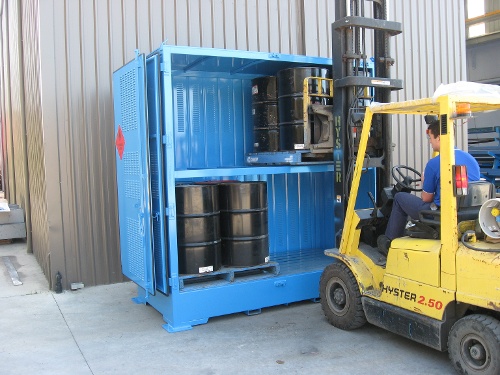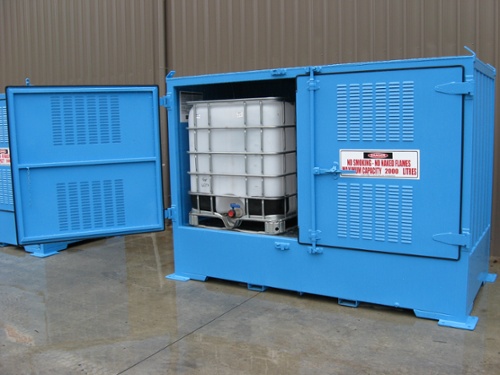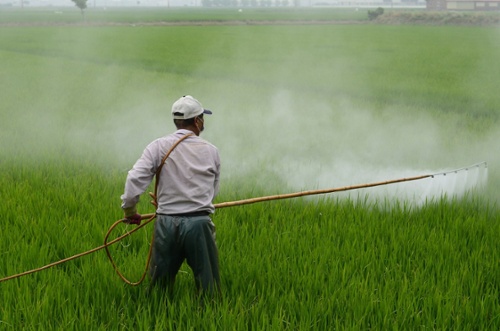Welcome to the final installment in our short blog series on pesticide and agricultural chemical requirements. In Part 3, we’ll be moving past the requirements for your chemical storage areas to discuss how you should be using and maintaining your store. Referring to the Australian Standard AS 2507:1998, we’ll be highlighting some key requirements that apply to the handling of your chemical products and the maintenance of your store.
Ensuring Adequate Ventilation
While Part 2 in our series noted the ventilation requirements for ag chemical and pesticide stores, it’s also important to remember that ventilation is required whenever you are using your chemicals. This includes pumping, decanting and the transferal of pesticides and agricultural chemicals.
As we know, many ag chemicals are classed as dangerous goods and can emit hazardous vapours that may result in asphyxiation, human harm or even ignition. The handling of your flammable or toxic chemicals must be done in such a way as to reduce these risks.
Therefore, AS 2507:1988 details the requirements for adequate ventilation in:
- Handling areas
- Filling areas
- Decanting areas
Wherever you choose to use your ag chemicals and pesticides, you must ensure that there is sufficient ventilation to allow for the dispersion of harmful or flammable vapours and gases. Many classes of dangerous goods will quickly emit large amounts of hazardous vapours during daily tasks such as refilling pesticide spraying machines or decanting chemicals into a smaller container.
Natural ventilation requirements include one or more of the following:
- Two opposite external sides which are open from floor to ceiling
- Vents in opposite external walls
- One side open and vents on the opposite or adjacent wall
- One external open side – as long as the distance to or the length of the opposite wall does not exceed the length of the open side
Mechanical ventilation systems must comply with a long list of requirements that include:
- System must have an airflow warning device
- Must be designed to it operates continuously or when staff are in the area
- Where flammable vapours are exhausted, all fan blades and nearby components must be made from materials that have minimal potential for giving off sparks when struck
IMPORTANT: For the full ventilation requirements for agricultural chemicals in handling, filling and decanting areas, refer to Section 3.5.6.2 of the Australian Standard AS 2507:1998.
Restricted Co-Storage With Other Goods
If you have been reading our blogs for some time, you will probably be aware of the fact that you should never mix different classes of chemicals (and sometimes even chemical products within the same class).
When using your agricultural chemicals, you must ensure that they don’t make accidental contact with a wide range of other substances and goods.
This includes prohibiting contact with a wide range of goods including, but not limited to:
- Animal feed and feed supplements
- Foodstuffs, materials or packaging
- Sanitisers
- Fertilizers such as pelletised manure
- Any type of oxidizing agents
- Gas cylinders
Incompatible substances can cause a range of issues for agricultural enterprises, including dangerous chemical reactions, the emission of hazardous gases and explosions. In your storage and handling areas, make sure you are mindful of keeping your specific agricultural chemicals and pesticides away from any type of incompatible substance.
IMPORTANT: To warn other workers or visitors to your farm of the dangerous associated with your agricultural chemicals, you should always ensure that the correct DG signage is displayed and that any hazard signs are also in place.
Battery Charging
Most agricultural enterprises rely on lead-acid or lithium-ion batteries to power their devices, equipment, vehicles and power tools. However, charging batteries can cause adverse chemical reactions which could involve the battery overheating, malfunctioning or even causing a fire.

Batteries for equipment such as forklifts and other vehicles should never be charged near your hazardous and flammable chemicals.
Therefore, it’s a requirement of the Australian Standard that battery charging is not carried out within a 10-metre distance of a stored flammable liquid in the same building.
It’s also important to note that spark-ignition forklift trucks must not be left unattended with the engine running within 10 metres of a flammable liquids storage area. This is also due to the risk of a spark-ignition forklift truck causing ignition with your stores of flammable agricultural chemicals. You should also never conduct maintenance of a forklift truck within the store.
Housekeeping Of Your Ag Chemical Store
Regardless of whether your chemicals are stored indoors, outdoors — or in a small or large quantity — maintaining regular upkeep of your hazardous chemical stores is essential for minimising risk.

To maintain compliance in your chemical stores, you must make sure that all housekeeping tasks are being completed on a regularly basis.
Reducing Risk Of Ignition
As we’ve mentioned earlier in this blog, Class 3 Flammable Liquids in your agricultural chemical stores can create a fire or explosion hazard. There are a multitude of ways that you can reduce this risk, including:
- Isolation of ignition sources from handling and storage areas
- No vegetation around your chemical store
- No combustible rubbish within at least 3 metres from the storage area perimeter
- No empty chemical containers
- Clearly visible warning signs in the area
Labelling and Containers
Many of your pesticides and ag chemicals may be classed as toxic substances. And as the name suggests, these chemicals can cause fatalities or severe harm to humans, farm animals, wildlife, waterways, soil and the wider natural environment. Other farm chemicals may be flammable, causing flashback, fire or explosion if the hazardous vapours meet an ignition source.
With so many risks associated with everyday ag chemicals, it’s important that all staff are aware of the chemicals that they’re handling – and their specific risks.
/How%20to%20manage%20hazardous%20chemicals%20in%20the%20workplace.jpg?width=600&name=How%20to%20manage%20hazardous%20chemicals%20in%20the%20workplace.jpg)
Knowing the properties and hazards associated with each chemical product at your site will help you determine the level of risk in your operations.
To reduce the risk of harm to people, property and the environment, you must always ensure that each ag chemical container is clearly marked with compliant labelling. It’s your responsibility to ensure that the chemical label remains intact and is clearly visible to staff who may be handling the substance.
IMPORTANT: Always refer to the Safety Data Sheet (SDS) of each agricultural chemical that your enterprise is carrying to understand the chemical and physical properties of the substance — and the hazards that they present. Keep your SDS is an easily accessible location close to your ag chemical store.
Old, damaged or leaking containers can also pose a range of risks, including chemical burns, asphyxiation and toxic poisoning. Your ag chemical containers should be regularly inspected for any signs of leaking, spillage or staining. If your chemicals arrive onsite in a delivery vehicle, you must ensure that the packages are in good working order before and after they are unloaded.
REMEMBER: Contaminated vehicles and chemical packages must not be unloaded to your operation without decontamination occurring. Ensure that all packages are handled carefully to avoid further leakage and damage during the decontamination process at your site.
Removing Old Products
If your ag enterprise is dealing with multiple farm chemicals and a multitude of products, you must make sure that the chemicals that you’re using are still safe and effective.
To avoid using products where the efficacy of the chemical is in doubt, you must rotate your stocks so that old chemicals and their packaging materials are disposed of safely.
Authorised Staff
We highly recommend that only authorised staff are permitted to enter your ag chemical storage and handling areas. Knowledge about the chemical hazards, emergency procedures and spill response should be included in staff training sessions for your employees and contractors.

Staff training is not only a recommendation for the handling or any type of dangerous goods, it’s a requirements under the Australian Standard.
All authorised personnel should understand:
- Location of first aid and fire protection equipment
- Procedures for emergencies including fires and chemical spills
- How to correctly use and maintain PPE
- The nature of their work
- How to safely use equipment
- The properties and hazards associated with the agricultural chemicals kept onsite
By keeping your staff up-to-date with training about your agricultural products, you’ll be helping create the safest possible working environment.
Maintaining A Safe Pesticide and Ag Chemical Store
As we’ve highlighted in Part 3 of our blog series, making sure that your ag chemical stores are used and maintained properly is necessary for safety and compliance. Whether you’re storing flammable liquids, toxic substances or other chemical classes, it’s important to understand the hazards associated with the product and implement the correct handling and storage practices.
To find out more about improving chemical compliance in your agricultural operations, you can access our helpful eBook. Identifying Hazardous Chemicals Used In The Workplace will introduce you to our simple 4-step risk management approach which can be easily applied to any area where you handle or store pesticides or ag chemicals. Grab your copy for free today and help maintain chemical safety in your agricultural operations.
Like to learn more about farm chemical storage and handling? Explore our entire short blog series
Part 1 Pesticide and Agricultural Chemical Requirements (Part 1): Minor Storage
Part 2 Pesticide and Agricultural Chemical Requirements (Part 2): Storage Areas
Joining the team as a Dangerous Goods Storage Consultant, Melissa Hampton became Storemasta's Marketing Manager in late 2021. With extensive knowledge and experience in chemical compliance, Melissa is responsible for leading the Marketing team and helping shape their marketing strategy. In her spare time, you can find Melissa hiking, swimming and enjoying the great outdoors in beautiful north-west Tasmania.

